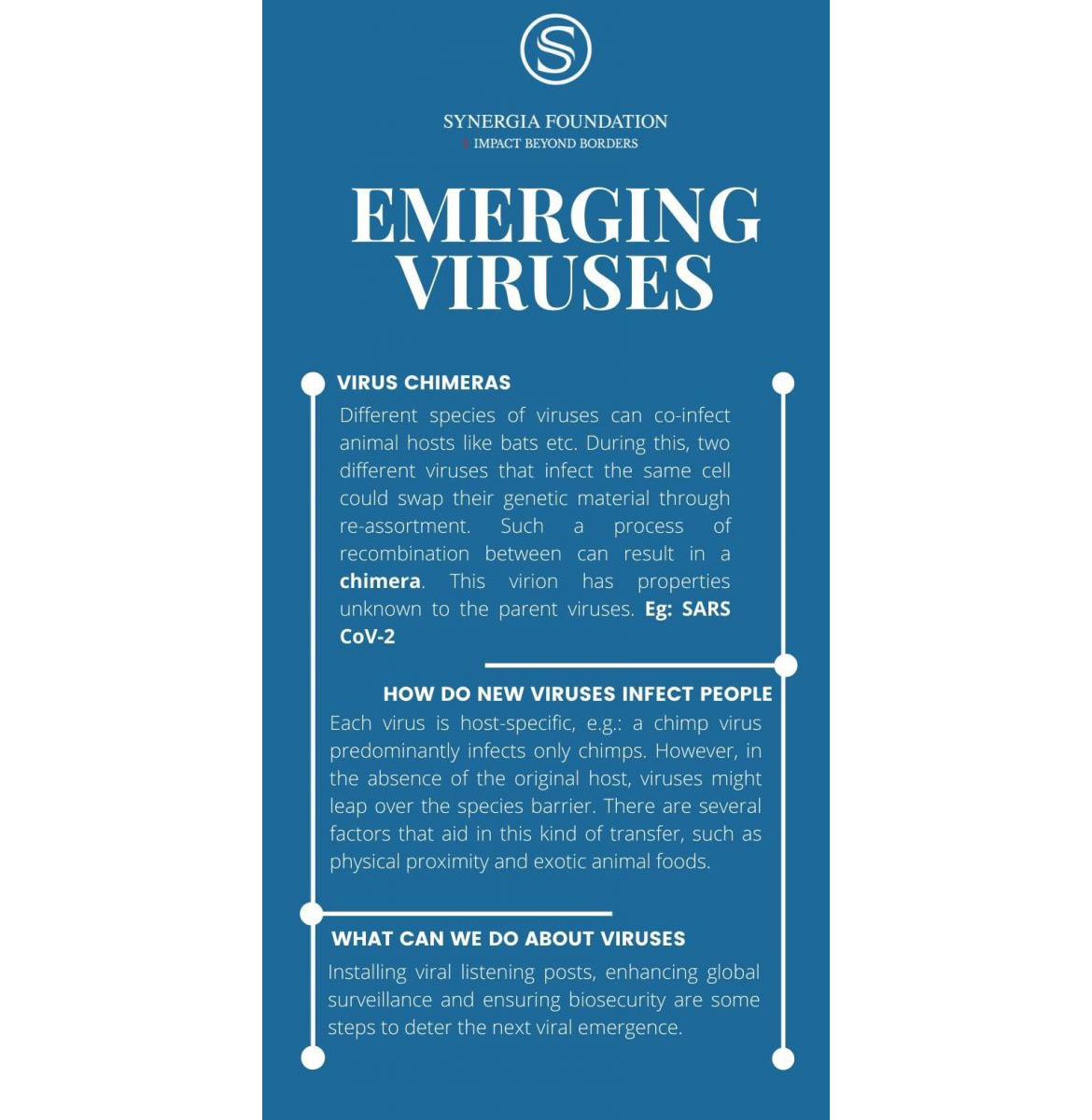Emerging Viruses
May 2, 2020 | Expert Insights

The Origins
Viruses are an enigma. They are simple, ancient and primordial in the evolutionary scale. A miniscule biomass of unique organisms that existed in early earth even before our descent. Viruses have played a pivotal role in shaping our genomes. Annals of human history would be incomplete without a deeper discourse on viruses. Adapted to extreme parasitism, viruses lack cellular organization or machinery. They hijack the host cell to replicate their progeny. Viruses emerge and re-emerge from their habitats and reservoirs when conditions are favorable.
Viral Zoonoses
Nearly 70 % of infectious diseases in humans are of animal origin like Influenzas, Ebola, Rabies and HIV/AIDS. Our increased contact with animals (wild as well as domestic) amplifies the chances of such animal viruses doing a species jump. Once inside a human host these viruses replicate and spread as the naïve human host offers very little immunological resistance to these invaders. So is the case of SARS CoV-2 causing COVID-19. This Coronavirus is understood to be a descendant of an ancestor bat virus that jumped into an intermediate host like pangolin (ant eater) and then to animal vendors in the wet markets. Though cooking can thermally inactivate such viruses, the act of butchering and de-skinning these animals in the wet markets pose a great risk. Bats, pangolins, badgers, palm cats, ferrets consumed as delicacies exposes human population to exotic viruses.
Virus Chimeras
Different species of viruses are known to co-infect animal hosts like bats, palm cats etc. During such an event two different viruses that infect the same target cell could swap its genetic material through re-assortment. Such a process of recombination between viruses can result in a chimera. Such a chimeric or recombined virion has properties previously unknown to the parent viruses. The SARS CoV-2 virus causing the current pandemic exhibits such properties previously unknown in bat coronaviruses.

Viral Evolution
Viruses compared to other higher organisms have shorter replication times.And in RNA viruses like SARS CoV-2, the fidelity of proof-reading is inherently error prone. Hence high number of mutants arise due to the mistakes in copying. This results in production of drug resistant and vaccine escape mutants. So, a virus which jumps from an animal reservoir and causes a pandemic in the human population will generate more mutants. Such a pool of mutant viruses increases the odds of success against host defenses. Under natural selection viruses evolve faster than their hosts. This makes it hard to treat or prevent a viral pandemic.
Viral Habitat & Ecology
Viruses are incapable of living in isolation, they can only sustain life inside another living reservoir like humans, bats, primates or badgers. Each virus is host-specific, for instance a chimp virus predominantly infects only chimps. However, in the absence of the original host or the abundance of alternative hosts, viruses might take a leap over the species barrier. There are several factors that aid in this kind of transfer. One is the spatial proximity of a new host, human infringement in a virus ecosystem, exotic animal foods, game meat and contact with wild animals. A reservoir is a sanctuary for a virus to live and self-propagate while the host itself might have adapted to co-exist with the virus as in the case of bats and SARS CoV-2.
Virus-Host Interaction
Humans share a very close relation with viruses. It is our very own cells that makes copies of the invading virus under the right genetic command. The interaction between a virus and its human host determines the outcome of the disease. In the case of viruses like SARS CoV-2, the virus can create an abnormal host immune response resulting in cytokine storms and hyper-activity of inflammatory markers. This has several deleterious effects in a COVID-19 infection. The delicate interaction between the virus and the human immune system determines the intensity of disease and death.
Virus Mediation Extinction
Viruses in the simplest terms could be described as self-replication molecules with a minimalistic design. Without a higher center for planning and decision making, viruses really do not have much of a forethought. A virus is only focused on self-propagation, it will endlessly replicate itself even if it means exhaustion and death of the human host. It has happened throughout history viruses have incessantly predated the host for its own preservation. The resultant extinction of the human host is neither foreseen nor does it matter to a virus. This is the greatest danger a virus can pose to its host population.
Virus Hunting
Our ancestors were hunter-gatherers. And hunting is an inborn trait that comes naturally to us. Humans have relentlessly hunted disease causing viruses in their reservoirs, habitats and hosts. Dedicated pioneers in fields, laboratories and hospitals have discovered, identified and studied some of the most dangerous viruses. However, this is a daunting task with an inherent risk to one’s own life. But the work of such scientists, physicians and epidemiologists has broadened our understanding of viruses. From the discovery of Ebola virus in remote parts of Africa to Hantavirus in forests of Asia, virus hunters have provided crucial information for the advancement of global health.
Antivirals and Vaccines
Virology is a relatively nascent field; it is less than 100 years old. In the brief history of vaccination, smallpox vaccine was the first successful viral vaccine discovered by Edward Jenner in 1798. Immunization eventually led to the eradication of smallpox by 1979. Louis Pasteur developed an effective rabies vaccine by 1885. We could not repeat the same success with a few other viral diseases. The first antiviral idoxuridine was synthesized around 1963, till date more than 100 antivirals have been produced. Still many viral diseases are in search for a cure.
Conclusion
Viruses occupy the frontiers of life, they shaped human history, created pestilences, killed more than wars or disasters and remain formidable foes. We have countered their strategies by designing vaccines and discovering drugs, and yet it always comes with a huge toll of lives. Instead we understand viruses and forecast their patterns of emergence, it would be easier to mitigate their devastating effects. We share our space in this biosphere with many life forms, and viruses are chief of them. Diverse groups of viruses with varying host specificities are present in the global virome. We have so far encountered only 1% of the trillion of viruses. A lethal virus emerging from the jungles of Africa or the wet markets of Asia or rainforests of Amazon is not a distant threat in this era of global interconnectedness. Viruses can overcome species barriers, downregulate host defenses and effectively adapt to a new species.Installing viral listening posts, enhancing global surveillance and ensuring biosecurity are some steps to deter the next viral emergence.
Author:Gifty Immanuel MD, PhD, MPH, FFPH
References
Fields Virology, 6th Edition by David M. Knipe and Peter M. Howley. Philadelphia, PA, USA. Lippincott Williams & Wilkins, 2013.
The Viral Storm: The Dawn of a New Pandemic Age by Nathan Wolfe, New York: Penguin Books, 2011.








Submitted by George John (not verified) on Mon, 05/04/2020 - 12:19
Exceptional presentation.
Exceptional presentation. Well thought out and very informative